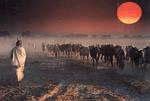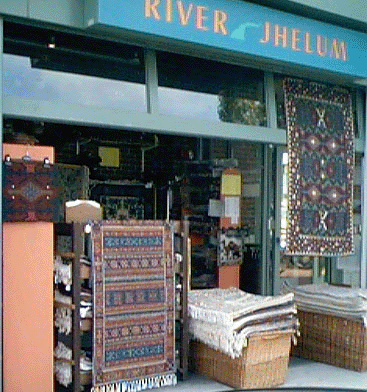
CHAKWAL Introduction
Chakwal was created as an independent district of Rawalpindi division in 1985 by combining subdivision Chakwal of district Jhelum, sub-division Talagang of district Attock and police station Choa Saidan Shah, carved out of subdivision Pind Dadan Khan, district Jhelum, and amalgamating it with sub-division Chakwal. Choa Saidan Shah was upgraded to the level of a sub-division in 1993.
District Chakwal is bordered by the districts of Rawalpindi and Attock in the north, district Jhelum in the east, district Khushab in the south and district Mianwali in the west. The total area of district Chakwal is 6609 square kilometers, which is equivalent to 1652443 acres, and as enumerated in the 1998 census the total population is 1059451, 87.7%% of which lives in rural areas and 12.3% in the urban areas, making Chakwal a predominantly rural district pivoted on an agrarian economy with a very small industrial sector.
Lying at the beginning of the Potohar plateau and the Salt Range, Chakwal is a barani district and the terrain is mainly hilly, covered with scrub forest in the southwest, and levelled plains interspaced with dry rocky patches in the north and northeast. The tribes clans and castes that inhabit this area are the Awans, Rajputs, Mehr Minhases, Kahuts, Mughals, Gujars, Gondals, Syeds, Arains and the Sheikhs. The physical features of the district, its tribes, its society and its economy all combine to make Chakwal one of the main recruiting areas for the Army and the Air Force. Other main occupations of the people are agriculture and mining. Transport and poultry business is also important.
At present district Chakwal consists of 3 subdivisions - Chakwal, Talagang and Choa Saidan Shah; 1 sub-tehsil- Kallar Kahar, 23 qanungois and 198 patwar circles. The police subdivisions correspond with those of the district administration and there are 11 police stations- Chakwal City, Saddar, Kallar Kahar, Dhumman, Nila, Dhudhial, Talagang City, Saddar, Tamman, Lawa and Choa Saidan Shah. The political establishment of Chakwal comprises of two seats in the National Assembly, NA-43 and NA-44, and four in the Provincial Assembly- PP-16, PP-17, PP-18 and PP-19. There is one district council, two municipal committees- Chakwal and Talagang and one town committee- Choa Saidan Shah.
DRESS
The dress that men, women and children of Chakwal district wear is very simple. Men generally wear shalwar Kumeez or Dhoti Kurta, a turban on special occasion, with Chappals, Khusas, Sandles or moccasins. In the winter months they add a coat, sweater or a Dhussa with it. The more educated class and the city dwellers also wear shirts with trousers, adding a coat and neck tie in the winters. Young boys can be seen wearing jeens and shirts occasionally.
Women almost invariably wear Shalwar Kameez with Dopatta, and a woolen Shawal or Sweater in the winter. Sarhis or western dresses are never worn. Footwear consists of Chappals or Sandals. On occasions of festivity the Kameez and Dopatta are heavily embroidered. Ornaments of gold and silver are also worn depending on the occasion and the financial position.
Young boys wear Kameez or a shirt with Knickers and young girls wear Shalwar Kameez or Frocks.
Agriculture
Farming is the main occupation of the people of Chakwal. With the exception of a few large landholders in subdivision Talagang, Holdings are small in the district and farming is conventional, though new techniques and methods are being introduced by the Barani Agricultural Institute, Thoa Bahadur, Chakwal. The farmers have also begun to use fertilizer and pesticides; and capital intensive, time saving inputs like tractors and harvesters, are being used eversince their introduction in the country.
The total area of the district is 1652443 acres, and the total cultivated area is 786212 acres. The main crops of the district are:
Wheat, Groundnut, Oil seeds,Grams, Lentils- Masoor, Moong, Mash, Maize, Millets, Jawar,Vegetables
Fruit orchards, especially of citrus, have also been planted by farmers but only on small areas owing to shortage of water. Fair sized Loquat orchards exist in Kallar Kahar and Choa Saidan Shah.
Agricultural activities in the district are looked after by the Department of Agriculture, Government of the Punjab, which is headed by the Deputy Director of Agriculture (Extension), who is assisted by two Extra Assistant Directors, 13 Agriculture Officers, 9 Agriculture Inspectors and 74 Field Assistants.
Pind Dadan Khan
25 March 1908, from Pind Dadan Khan (Jhelum District), Punjab. Describing a fair in the neighbouring district of Attock; Kattak dance.
Jhelum
A nice place to visit, a great place to live !

HISTORY ROOTS OF TEHSIL JHELUM
In 1881 Tehsil Jhelum
population was 21107( Male 14963,Female 6144).Distict Jhelum used to be
comprised of Tehsil Jhelum,Pindaden Khan,Chakwal and Talagung during British
rule(1884)
Tehsil Jhelum is divided into 3 sectors,Photohar(sohawa,Lehri,surkdhan,Pari
dervanra, out of which Lehri was inhabited by Moughal empror Shah
Jahan)PunjGriaian(where Gujar cast is inhabited in 5 villages).Riversided Area
(including Dara pur,badlot,Malot,Nogran,sanghoi,Saiela,Thalianwala,Chak
Doulat,mera,Jakar,Patan gatali,Dina,Madho kalas,Rohtas,Thatti
mughlan,cittan,munon,Kala gujran,Chak Jamal Sagri,Etc.
Dina: This town is named after Baba Deen Mohammad,a soldier in Mahmood Ghaznivi Force and gateway to azad kashmir.It is dominated by Miania,Shiekh and kashmiri family.
DARAPUR: In 516BC Irian Empror Dara Gustasip inhabitated the village.
BADLOT: Famous for Kiyani & ghukkar casts named after Raja Badli Khan.
SANGHOI: Famous for Tomb of Hazrat Akbar Ali alias cheeni sarkar Sain Gharibo also belogs to sangohi.
TALLIAN WALA: Famous for abdunce ofSheshim Trees.Hazarat MiranHaider Ali Shah who was Qutub during the period of Ahmad Shah Abdali is burried here.
PUTEN GATALI: Alexender the great crossed river Jhelum from this point.
JAKAR: Famous for religious point of view.
THATTI MUGHLAN: This marshall area was inhabited by ancestors of Mirza Azam Baig in Empror Aurang zaib period.
GUJAR PUR: Famous for Tomb of Hazarat Buga Sher.This is near PTC.
LUNGAR PUR: This historical town was inhabited byGogi,the elder son of suleman piswal(founder of kala gujran)in Saleem shah soori period.Mian Ghulam Hussain,a saint, who died in 1886 is burried here.
CHAK JAMAL: This town is first inhabited by Jamal a son of suleman Piswal in saleem shah soori reign.
DOMELI: An ancient dwelling of Ghukkar cast and a marshall area.
KALA GUJRAN: Founded by Ch.Suleman Gujar about 800-900 years before.
CHITTEN: Birth place of famous writer ,publisher,journalist and religious scholer MOLVI FAQIR MOHAMMAD who later started a printing press and first Newspaper SIRAJ UL AKHBAR.from maidan pakistan in 1870 and this paper ceased publication around 1910..He is father of Mrs.Abdul Qadir a story writer and grandfather of SIRAJ UDDIN ZAFER a renowned poet of Pakistan.

 Life
without the fear of prosecution
Life
without the fear of prosecution 
 An
Old Vedah
An
Old Vedah 



